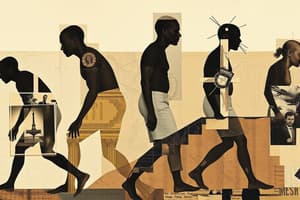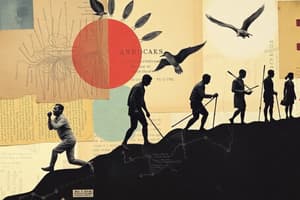Podcast
Questions and Answers
Which characteristic is associated with Homo habilis?
Which characteristic is associated with Homo habilis?
- Crafted materials
- Hunted for food
- Lived in shelters
- Brain size of 700 cc (correct)
What distinguishes Homo erectus from earlier species?
What distinguishes Homo erectus from earlier species?
- Smaller teeth and face
- Larger brain size of 1000 cc (correct)
- Lived exclusively in caves
- Predominantly carnivorous diet
What term refers to the only extant human species?
What term refers to the only extant human species?
- Homo neanderthalensis
- Homo habilis
- Homo sapiens (correct)
- Homo floresiensis
What was the primary mode of living for most humans during the Neolithic age?
What was the primary mode of living for most humans during the Neolithic age?
What is the main difference between socialization and enculturation?
What is the main difference between socialization and enculturation?
Which hominin is commonly referred to as 'the Hobbit'?
Which hominin is commonly referred to as 'the Hobbit'?
What did Cro-Magnon man develop towards the end of the hunting and gathering period?
What did Cro-Magnon man develop towards the end of the hunting and gathering period?
What does the 'nature principle' imply about human personality and identity?
What does the 'nature principle' imply about human personality and identity?
What does the nurture principle emphasize regarding personality development?
What does the nurture principle emphasize regarding personality development?
In Jean Piaget's Theory of Cognitive Development, how many stages are proposed?
In Jean Piaget's Theory of Cognitive Development, how many stages are proposed?
What does biological evolution primarily refer to?
What does biological evolution primarily refer to?
Which theory extends Freud's ideas regarding human development throughout the lifespan?
Which theory extends Freud's ideas regarding human development throughout the lifespan?
What is the focus of Lawrence Kohlberg's Theory of Moral Development?
What is the focus of Lawrence Kohlberg's Theory of Moral Development?
Which of the following best describes cultural evolution?
Which of the following best describes cultural evolution?
What is the outcome process that explains the frequencies of traits in a particular environment?
What is the outcome process that explains the frequencies of traits in a particular environment?
According to George Herbert Mead, personality development is primarily a product of what?
According to George Herbert Mead, personality development is primarily a product of what?
What principle of natural selection refers to the variety of individuals within a species?
What principle of natural selection refers to the variety of individuals within a species?
What does social control aim to achieve in society?
What does social control aim to achieve in society?
What are formal means of social control characterized by?
What are formal means of social control characterized by?
Which of these hominids is known for having both apelike and humanlike characteristics?
Which of these hominids is known for having both apelike and humanlike characteristics?
Which hominid is described as capable of walking upright on the ground and moving on all fours in trees?
Which hominid is described as capable of walking upright on the ground and moving on all fours in trees?
What is a common misconception about the nature vs. nurture debate in identity development?
What is a common misconception about the nature vs. nurture debate in identity development?
How does Australopithecus differ from other hominids?
How does Australopithecus differ from other hominids?
What do the principles of natural selection indicate about differential reproductive success?
What do the principles of natural selection indicate about differential reproductive success?
What is the primary function of informal means of social control?
What is the primary function of informal means of social control?
Which of the following best describes deviance?
Which of the following best describes deviance?
Which of the following concepts emphasizes the rights inherent to all human beings?
Which of the following concepts emphasizes the rights inherent to all human beings?
What distinguishes primary groups from secondary groups?
What distinguishes primary groups from secondary groups?
What type of group serves as a standard for measuring our behavior and attitudes?
What type of group serves as a standard for measuring our behavior and attitudes?
Which factor would create an individual's identity within an out-group?
Which factor would create an individual's identity within an out-group?
Which of the following best explains the concept of common good?
Which of the following best explains the concept of common good?
In-group and out-group distinctions are influenced by which of the following factors?
In-group and out-group distinctions are influenced by which of the following factors?
Study Notes
Biological and Cultural Evolution
- Biological evolution encompasses genetic changes and trait variations in populations across generations, evident in human bone structure.
- Cultural evolution illustrates the transformation of human cultures from simple to complex forms, analyzed through changes in lifestyle.
- Sociopolitical evolution refers to the gradual structural reorganization over time leading to significantly different societal forms compared to ancestral structures.
Natural Selection Principles
- Variation signifies the diversity among individuals in a species, with certain traits being better suited to environments.
- Heritability highlights the ability for organisms to pass on diverse traits to their offspring.
- Differential reproductive success explains how organisms with favorable traits are likely to survive and reproduce, perpetuating those traits in future generations.
Categories of Hominids
- Sahelanthropus (7 million years ago): Exhibited ape-like and human-like traits with a skull resembling australopithecines and a brain size of 320-380 cc.
- Ardipithecus ("Ape on the Ground", 5.6 million years ago): Capable of upright walking and tree movement; includes two types: Ardipithecus kadabba and Ardipithecus ramidus.
- Australopithecus ("Southern Ape", 5 million to 1 million years ago): Bipedal with a brain size of approximately 500 cc; classified as humans due to their larger brains and bipedalism yet were tool users, not makers.
Categories of Homo
- Homo habilis: Known as the earliest Homo with a height of about 3-4 feet and a brain size of 700 cc, labeled as "Handyman" for its tool usage.
- Homo erectus: Featured a larger brain (1000 cc), lived in shelters, gathered food, and crafted materials.
- Homo sapien Neanderthalensis: Larger brain than modern humans; robust physique, carnivorous, lived in groups, and known for advanced hunting tools.
- Homo sapiens: Extant human species known as "wise man," evolved in Africa, adept at hunting, gathering, and utilizing behaviors for survival.
- Homo floresiensis ("The Hobbit"): Small-bodied species found in Indonesia, lived from 100,000 to 25,000 years ago.
Neolithic Age Developments
- Most prehistoric humans engaged in hunting and gathering; advancements led to the development of art and complex tools like knives and spears.
- Improved tools increased food supply, fostering population growth.
Enculturation and Socialization
- Socialization is a lifelong process where individuals learn culture, starting from infancy and continuing until death.
- Enculturation enables individuals to share culture through experiences and observations.
- The "nature vs. nurture" debate reflects on whether personality is inherited (nature) or shaped by social interactions (nurture).
Theories of Identity Formation
- Freud's Psychodynamic Theory emphasizes the role of sexual and aggressive urges in personality development.
- Piaget's Theory highlights cognitive processes across four stages (sensorimotor, preoperational, concrete operational, formal operational) in childhood development.
- Kohlberg's Moral Development Theory asserts that moral identity evolves through experiences, based on Piaget's ideas.
- Erikson's theory extends development into old age, at various life stages.
- Mead's Theory emphasizes that identity is crafted through social interaction and meaningful exchanges.
Conformity and Deviance
- Social control refers to societal mechanisms that encourage conformity to acceptable behaviors.
- Conformity is engaging in socially acceptable actions; Ross argues it's foundational for societal order.
- Social control is executed formally (laws, education) and informally (internalized norms).
- Informal control is effective due to sympathy, sociability, and a sense of justice.
- Deviance involves acts that violate cultural norms.
Human Dignity, Rights, and Common Good
- Human dignity signifies the inherent respect and value due to all individuals.
- Human rights are universal entitlements irrespective of status, as defined by the United Nations.
- Common good encompasses shared values and structures that benefit all community members.
Society Organization and Social Groups
- Groups allow individuals to interact and find belonging.
- Primary groups are small, intimate, and long-lasting, while secondary groups are larger and centered around shared purposes.
- In-groups comprise individuals who identify strongly with a group; out-groups are those with which they do not identify.
- Factors influencing group identity include culture, gender, age, and religion.
- Reference groups provide standards for measuring behaviors and attitudes; they can be informational or formal in nature.
Studying That Suits You
Use AI to generate personalized quizzes and flashcards to suit your learning preferences.
Related Documents
Description
Test your knowledge on the concepts of biological and cultural evolution, along with natural selection principles. This quiz covers the key aspects of how species adapt over generations and the evolution of human cultures. Explore the categories of early hominids and understand the basic principles that drive evolution.




